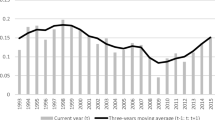Abstract
This paper attempts to identify the determinants ofhazard confronting 219 new manufacturing firmsestablished in 1982–84 and followed up to1992 using a Cox regression model. Three sets ofvariables are combined in the analysis: firm, sectorand cohort specific. Financial, firm specificcharacteristics such as larger initial financialcapital size, conservative borrowing, heavier fixedasset commitment and lower diversification in terms ofholding other firms' assets are estimated to reducefirm hazard. Higher sectoral entry and lower sunk costsectoral requirements by increasing marketcontestability increase risk of failure together withcyclical variations.
Similar content being viewed by others
References
Agarwal, R. (1997) ‘Survival of Firms over the Product Life Cycle, Southern Journal of Economics, 63, 571–84.
Anagnostaki, V., and H. Louri (1995) ‘Entry and Exit from Greek Manufacturing Industry: a Test of the Symmetry Hypothesis’, International Review of Applied Economics, 9, 86–95.
Audretsch, D. B. (1991) ‘New-Firm Survival and the Technological Regime’, Review of Economics and Statistics, 73, 441–450.
Audretsch, D. B. (1994) ‘Business Survival and the Decision to Exit’, Journal of the Economics of Business, 1, 125–137.
Audretsch, D. B. (1995a) Innovation and Industry Evolution. Cambridge, MA, London, U.K.: The MIT Press.
Audretsch, D. B. (1995b) ‘Innovation, growth and survival’, International Journal of Industrial Organization, 13, 441–457.
Audretsch, D. B., and T. Mahmood (1993) ‘Entry, Growth, and Survival: The New Learning on Firm Selection and Industry Evolution’, Empirica, 20, 25–33.
Audretsch, D. B., and T. Mahmood (1994) ‘The Rate of Hazard Confronting New Firms and Plants in U.S. Manufacturing’, Review of Industrial Organization, 9, 41–56.
Audretsch, D. B. and Mahmood, T. (1995) ‘New Firm Survival: New Results Using a Hazard Function’, Review of Economics and Statistics, 97, 97–103.
Audretsch, D. B., and J. Mata (1995) ‘The Post-Entry Performance of Firms: Introduction’, International Journal of Industrial Organization, 13, 413–419.
Baden-Fuller, C. W. F. (1989) ‘Exit from Declining Industries and the Case of Steel Castings’, The Economic Journal, 99, 949–961.
Baldwin, J., and P. Gorecki (1990) ‘Firm Entry and Exit in the Canadian Manufacturing Sector’, 1970–1982. Canadian Journal of Economics, 24, 300–323
Baldwin, J. R., and M. Rafiquzzaman (1995) ‘Selection versus Evolutionary Adaptation: Learning and Post-Entry Performance’, International Journal of Industrial Organization, 13, 501–522.
Boeri, T., and L. Bellmann (1995) ‘Post-Entry Behaviour and the Cycle: Evidence from Germany’, International Journal of Industrial Organization, 13, 483–458.
Bradburd, R., and R. E. Caves (1982) ‘A Closer Look at the Effect of Market Growth and Industries’ Profits’, Review of Economics and Statistics, 64, 635–645.
Breslow, N. (1974) ‘Covariance Analysis of Censored Survival Data’, Biometrics, 30, 89–99.
Caves, R. E., and M. E. Porter (1976) ‘Barriers to Exit’, in Robert T. Masson and P. D. Qualls, eds. Essays on Industrial Organisation in Honour of Joe Bain. Cambridge: Ballinger.
Caves, R. E., and M. E. Porter (1977) ‘From Entry to Mobility Barriers: Conjectural Decisions and Contrived Deterrence to New Competition’, Quarterly Journal of Economics, 91, 241–261.
Cox, D. R. (1972) ‘Regression Models and Life-Tables’, Journal of Royal Statistical Society Series B, 34, 187–220.
Cox, D. R. (1975) ‘Partial likelihood’, Biometrica, 62, 269–276.
Cutler, S. J., and F. Ederer (1958) ‘Maximum Utilization of the Life Table Method in Analysing Survival’, Journal of Chronic Diseases, 699–712.
Doms, M., T. Dunne, and M. J. Roberts (1995) ‘The Role of Technology Use in the Survival and Growth of Manufacturing Plants’, International Journal of Industrial Organization, 13, 523–542.
Dunne, P., and A. Hughes (1994) ‘Age, Size, Growth and Survival: UK Companies in the 1980s’, Journal of Industrial Economics, 42, 115–140.
Dunne, T., and M. Roberts (1991) ‘Variation in Producer Turnover across U.S Manufacturing Industries’, in P. A. Geroski and Joachim Schwalbach, eds. Entry and Market Contestability: An International Comparison. London: Basil Blackwell, pp. 187–203.
Dunne, T., M. Roberts, and L. Samuelson (1988) ‘Patterns of Firm Entry and Exit in U.S. Manufacturing Industries’, Rand Journal of Economics, 19, 495–515.
Dunne, T., M. Roberts, and L. Samuelson, (1989) ‘The Growth and Failure of US Manufacturing Plants’, Quarterly Journal of Economics, 104, 671–698.
Evans, D. (1987a) ‘Tests of Alternative Theories of Firm Growth’, Journal of Political Economy, 95, 657–674.
Evans, D. (1987b) ‘The Relationship between Firm Growth, Size, and Age: Estimates for 100 Manufacturing Industries’, The Journal of Industrial Economics, 35, 567–581.
Fotopoulos, G., and N. Spence, (1998) ‘Entry and Exit from Manufacturing Industries: Symmetry, Turbulence and Simultaneity – Some Empirical Evidence from Greek Manufacturing Industries, 1982–1988’, Applied Economics, 30, 245–262.
Geroski, P. (1995) ‘What Do We Know about Entry?’, International Journal of Industrial Organization, 13, 421–440.
Greene, W. H. (1997) Econometric Analysis, 3rd edn. New Jersey: Prentice Hall.
Hall, B. H. (1987) ‘The Relationship between Firm Size and Firm Growth in the US Manufacturing Industries’, Journal of Industrial Economics, 35, 583–606.
Jovanovic, B. (1982) ‘Selection and Evolution of Industry’, Econometrica, 50, 3–37.
Kiefer, N. M. (1988) ‘Economic Duration Data and Hazard Functions’, Journal of Economic Literature, 26, 646–679.
Mahmood, T. (1992) ‘Does the Hazard Rate of New Plants Vary between High-and-Low-Tech Industries?’, Small Business Economics, 4, 201–210.
Mata, J. (1994) ‘Firm Growth during Infancy’, Small Business Economics, 6, 27–40.
Mata, J., and P. Portugal (1994) ‘Life Duration of New Firms’, Journal of Industrial Economics, 27, 227–243.
Mata, J., P. Portugal, and P. Guimaraes (1995) ‘The Survival of New Plants: Start-Up Conditions and Post Entry Evolution’, International Journal of Industrial Organization, 13, 459–481.
Wagner, J. (1992) ‘Firm Size, Firm Growth, and Persistence of Chance: Testing Gibrat's Law with Establishment Data from Lower Saxony’, Small Business Economics, 4, 125–131.
Wagner, J. (1994) ‘The Post-Entry Performance of New Small Firms in German Manufacturing Industries’, The Journal of Industrial Economics, 42, 141–154.
Author information
Authors and Affiliations
Rights and permissions
About this article
Cite this article
Fotopoulos, G., Louri, H. Determinants of Hazard Confronting New Entry: Does Financial Structure Matter?. Review of Industrial Organization 17, 285–300 (2000). https://doi.org/10.1023/A:1007862922531
Issue Date:
DOI: https://doi.org/10.1023/A:1007862922531




